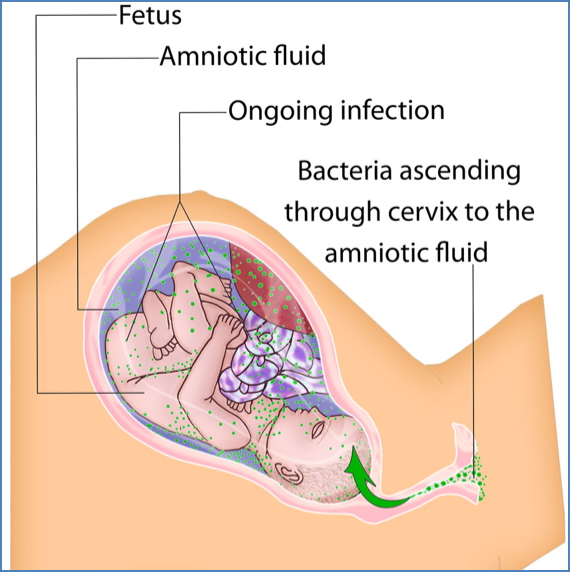Table of Contents
Overview – Complications of Labour
Complications of labour are critical obstetric emergencies that pose risks to both mother and baby. These include mechanical issues such as shoulder dystocia, cord-related events like umbilical cord prolapse, uterine injuries such as uterine rupture, and infectious processes like chorioamnionitis. Prompt recognition and management of these complications are essential to prevent perinatal morbidity and mortality.
Shoulder Dystocia
Definition
- A delivery complication where the fetal anterior shoulder becomes impacted behind the maternal pubic symphysis after the head has been delivered.
Aetiology
- Disproportion between fetal shoulder width and maternal pelvis (shoulders wider than biparietal diameter).
- Risk factors:
- Maternal obesity
- Diabetes
- Macrosomia
- Prolonged gestation
- Prolonged second stage of labour
Clinical Features
- Turtle sign: Head retracts against perineum after delivery
- Complications:
- Fetal hypoxic encephalopathy
- Brachial plexus injury
- Clavicle/humerus/cervical spine fractures
- Neonatal death
- Postpartum haemorrhage (PPH)
- Uterine rupture
Management
- Immediate obstetric manoeuvres to free the impacted shoulder:
- McRobert’s manoeuvre
- Suprapubic pressure
- Delivery of posterior arm
- Episiotomy
- Advanced techniques: Cleidotomy, Zavanelli manoeuvre, or symphysiotomy
Prognosis
- ~1% risk of permanent neonatal disability


2. McRobert’s Manoeuvre: geraldbaeck, CC0, via Wikimedia Commons
Umbilical Cord Prolapse
Definition
- Cord descends below or alongside the presenting part, leading to potential compression between the fetus and pelvis.
Risk Factors
- Prematurity
- Premature rupture of membranes (PROM)
- Fetal malpresentation
- Low-lying placenta
- Polyhydramnios
- Multiple gestation
Clinical Features
- Visible or palpable cord
- Fetal bradycardia or variable decelerations on cardiotocography
Management
- Emergency Caesarean section
- Maternal positioning (e.g., all fours or Trendelenburg)
- Manual elevation of presenting part to relieve compression
- Supplemental oxygen
Prognosis
- Can lead to acute fetal hypoxia and demise if not promptly addressed

Uterine Rupture
Aetiology
- Rupture of the uterus, often due to:
- Previous Caesarean section scar (40% of cases)
- Uterine hyperstimulation (e.g. with oxytocin)
- Grand multiparity
Clinical Features
- Prolonged fetal bradycardia
- Acute lower abdominal pain
- Vaginal bleeding
- Intra-abdominal haemorrhage
- Sudden loss of fetal station
Management
- Immediate laparotomy and delivery
- Hysterectomy may be required
- Aggressive fluid resuscitation and shock management
Prognosis
- Maternal mortality: 1–10%
- Fetal mortality: up to 50%


2. Unattributable
Chorioamnionitis
Aetiology
- Infection of the placental membranes (chorion and amnion)
- Risk factors:
- Prolonged labour
- Preterm PROM or PROM
- Vaginal flora or transplacental pathogens (e.g. HSV, CMV, syphilis, toxoplasmosis)
Pathophysiology
- Ascending infection or haematogenous spread leads to inflammation and potential sepsis
Morphology
- Macroscopic: Abscesses on placental surface
- Microscopic:
- Neutrophilic infiltration (chorionic plate)
- Umbilical vasculitis
- Infarctions
Clinical Features
- Maternal:
- Fever
- Uterine tenderness
- Neonatal:
- Sepsis
- Asphyxia
- Microcephaly
- Hearing loss
- Hepatosplenomegaly
- Miscarriage or stillbirth
Management
- Empirical IV antibiotics:
- Ampicillin + Gentamicin + Clindamycin
- Prompt induction of labour
Prognosis
- Low maternal mortality if treated
- High risk of serious neonatal outcomes, especially with TORCH infections

Summary – Complications of Labour
Complications of labour, such as shoulder dystocia, umbilical cord prolapse, uterine rupture, and chorioamnionitis, require prompt and skilled management to minimise risks to both mother and child. These emergencies vary in cause—from mechanical to infectious—but all share the potential for serious outcomes including hypoxia, haemorrhage, and neonatal death. For a broader context, see our Obstetrics Overview page.